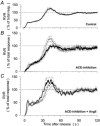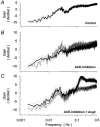Role of angiotensin II in dynamic renal blood flow autoregulation of the conscious dog
- PMID: 11773325
- PMCID: PMC2290019
- DOI: 10.1113/jphysiol.2001.012593
Role of angiotensin II in dynamic renal blood flow autoregulation of the conscious dog
Abstract
The influence of angiotensin II (ANGII) on the dynamic characteristics of renal blood flow (RBF) was studied in conscious dogs by testing the response to a step increase in renal artery pressure (RAP) after a 60 s period of pressure reduction (to 50 mmHg) and by calculating the transfer function between physiological fluctuations in RAP and RBF. During the RAP reduction, renal vascular resistance (RVR) decreased and upon rapid restoration of RAP, RVR returned to baseline with a characteristic time course: within the first 10 s, RVR rose rapidly by 40 % of the initial change (first response, myogenic response). A second rise began after 20-30 s and reached baseline after an overshoot at 40 s (second response, tubuloglomerular feedback (TGF)). Between both responses, RVR rose very slowly (plateau). The transfer function had a low gain below 0.01 Hz (high autoregulatory efficiency) and two corner frequencies at 0.026 Hz (TGF) and at 0.12 Hz (myogenic response). Inhibition of angiotensin converting enzyme (ACE) lowered baseline RVR, but not the minimum RVR at the end of the RAP reduction (autoregulation-independent RVR). Both the first and second response were reduced, but the normalised level of the plateau (balance between myogenic response, TGF and possible slower mechanisms) and the transfer gain below 0.01 Hz were not affected. Infusion of ANGII after ramipril raised baseline RVR above the control condition. The first and second response and the transfer gain at both corner frequencies were slightly augmented, but the normalised level of the plateau was not affected. It is concluded that alterations of plasma ANGII within a physiological range do not modulate the relative contribution of the myogenic response to the overall short-term autoregulation of RBF. Consequently, it appears that ANGII augments not only TGF, but also the myogenic response.
Figures



Similar articles
-
Dynamic characteristics and underlying mechanisms of renal blood flow autoregulation in the conscious dog.Am J Physiol Renal Physiol. 2001 Jun;280(6):F1062-71. doi: 10.1152/ajprenal.2001.280.6.F1062. Am J Physiol Renal Physiol. 2001. PMID: 11352846
-
Dynamics and contribution of mechanisms mediating renal blood flow autoregulation.Am J Physiol Regul Integr Comp Physiol. 2003 Sep;285(3):R619-31. doi: 10.1152/ajpregu.00766.2002. Epub 2003 Jun 5. Am J Physiol Regul Integr Comp Physiol. 2003. PMID: 12791588
-
Autoregulation of renal blood flow in the conscious dog and the contribution of the tubuloglomerular feedback.J Physiol. 1998 Jan 1;506 ( Pt 1)(Pt 1):275-90. doi: 10.1111/j.1469-7793.1998.275bx.x. J Physiol. 1998. PMID: 9481688 Free PMC article.
-
Molecular mechanisms of renal blood flow autoregulation.Curr Vasc Pharmacol. 2014;12(6):845-58. doi: 10.2174/15701611113116660149. Curr Vasc Pharmacol. 2014. PMID: 24066938 Free PMC article. Review.
-
Renal autoregulation: new perspectives regarding the protective and regulatory roles of the underlying mechanisms.Am J Physiol Regul Integr Comp Physiol. 2006 May;290(5):R1153-67. doi: 10.1152/ajpregu.00402.2005. Am J Physiol Regul Integr Comp Physiol. 2006. PMID: 16603656 Free PMC article. Review.
Cited by
-
Kidney diseases and COVID-19 infection: causes and effect, supportive therapeutics and nutritional perspectives.Heliyon. 2021 Jan;7(1):e06008. doi: 10.1016/j.heliyon.2021.e06008. Epub 2021 Jan 20. Heliyon. 2021. PMID: 33495739 Free PMC article. Review.
-
Transfer Function Analysis of Dynamic Blood Flow Control in the Rat Kidney.Bull Math Biol. 2016 May;78(5):923-60. doi: 10.1007/s11538-016-0168-y. Epub 2016 May 12. Bull Math Biol. 2016. PMID: 27173401 Free PMC article.
-
Renal autoregulation and blood pressure management in circulatory shock.Crit Care. 2018 Mar 22;22(1):81. doi: 10.1186/s13054-018-1962-8. Crit Care. 2018. PMID: 29566705 Free PMC article. Review.
-
Connecting tubule glomerular feedback antagonizes tubuloglomerular feedback in vivo.Am J Physiol Renal Physiol. 2010 Dec;299(6):F1374-8. doi: 10.1152/ajprenal.00403.2010. Epub 2010 Sep 8. Am J Physiol Renal Physiol. 2010. PMID: 20826574 Free PMC article.
-
Blood pressure-renal blood flow relationships in conscious angiotensin II- and phenylephrine-infused rats.Am J Physiol Renal Physiol. 2013 Oct 1;305(7):F1074-84. doi: 10.1152/ajprenal.00111.2013. Epub 2013 Jul 3. Am J Physiol Renal Physiol. 2013. PMID: 23825067 Free PMC article.
References
-
- Abe Y, Kishimoto T, Yamamoto K. Effect of angiotensin II antagonist infusion on autoregulation of renal blood flow. American Journal of Physiology. 1976;231:1267–1271. - PubMed
-
- Ajikobi DO, Novak P, Salevsky FC, Cupples WA. Pharmacological modulation of spontaneous renal blood flow dynamics. Canadian Journal of Physiology and Pharmacology. 1996;74:964–972. - PubMed
-
- Arendshorst WJ, Finn WF. Renal hemodynamics in the rat before and during inhibition of angiotensin II. American Journal of Physiology. 1977;233:F290–297. - PubMed
-
- Braam B, Koomans HA. Nitric oxide antagonizes the actions of angiotensin II to enhance tubuloglomerular feedback responsiveness. Kidney International. 1995;48:1406–1411. - PubMed
Publication types
MeSH terms
Substances
LinkOut - more resources
Full Text Sources
Miscellaneous

